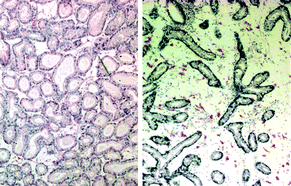In order to assess the biological effects of the Prestige oil spill (POS), mussels, Mytilus galloprovincialis, were collected in 22 localities along the North coast of the Iberian Peninsula over 3 years (April 2003–April 2006). Different tissue-level biomarkers including cell type composition (volume density of basophilic cells, VvBAS) in digestive gland epithelium, structural changes of digestive alveoli (mean luminal radius to mean epithelial thickness, MLR/MET) and histopathological alterations (prevalence and intensity) of the digestive gland were analysed. Severe alterations in the general condition of the digestive gland tissue were observed all over the study area up to 2004–2005. High VvBAS values were recorded mainly in Galicia but also to a lesser extent in the Bay of Biscay in 2003–2004. Atrophy of the digestive alveoli, measured in terms of MLR/MET, was detected all along the studied area up to 2006. Inflammatory responses cannot be related to pollution due to the POS: (a) prevalence and intensity of focal hemocytic infiltration were higher in the Bay of Biscay than in Galicia but they did not show a clear temporal trend; (b) high intensities of brown cell aggregates were only sporadically recorded; and (c) granulocytomas were more frequently recorded in the Bay of Biscay than in Galicia and especially in localities (i.e. Arrigunaga) subjected to chronic pollution. Likewise, Marteilia, trematodes, intracellular ciliates, unidentified eosinophilic bodies, R/CLO and Mytilicola did not follow any recognisable pattern that could be associated to the POS. In contrast, high Nematopsis intensities recorded in several localities in 2003 might suggest some response of local interest after the POS (i.e., in combination with particular factors/conditions). More data at a regional scale are needed before histopathology may provide a reliable ecosystem health assessment but the present results suggest that the approach is worthwhile. Overall, although VvBAS returned to reference values by 2004–2005, MLR/MET values indicated that the mussel health condition was affected during the whole study period up to April 2006.


 Please wait while we load your content...
Please wait while we load your content...